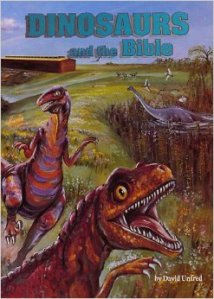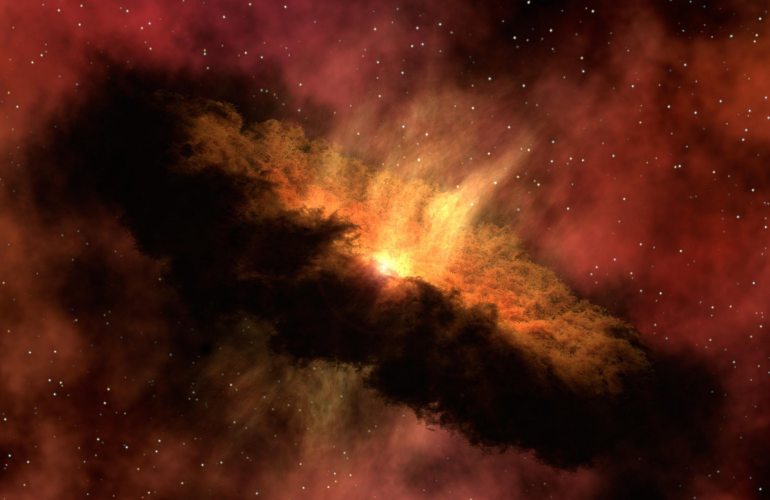When I was ten years old, our church library ordered a book called Dinosaurs and The Bible.
I couldn’t have been more excited. Like most ten-year-olds, I was a huge dinosaur nerd. When I grew up, I wanted to be a paleontologist, and I could rattle off the Latin names for all my favorite dinosaurs.
The week it arrived at our church, the pastor told the congregation their children needed to read the book – especially if they were receiving “public school education.”
I was, of course, the first in line to borrow it from the church library.

The crux of Dinosaurs and the Bible hinged on the idea that since God created everything in six literal days about 10,000 years ago, dinosaurs and humans definitely co-existed at the same time in history.
I devoured the book. It was filled with wild artwork, colorful charts, and scientific explanations of key Biblical passages.
However, the more I read of Dinosaurs and the Bible, the more uneasy I became.
The first red flag was the book’s chapter about Noah’s Ark, which claimed that in order to fit dinosaurs on the Ark to save them from the Great Flood, God probably helped Noah by either shrinking the dinosaurs or giving him dinosaur eggs.
Okay, weird, I thought. But I can go with it.
But it was the book’s final chapter about my favorite dinosaur – the Tyrannosaurus Rex – that finally tipped me over the edge.
Deemed the “King of the Dinosaurs,” the T-Rex was a ferocious predator the size of a school bus. But, the book claimed that since pain and death didn’t exist prior to The Fall, the T-Rex was originally designed by God as a plant-eating reptile.
The chapter even included an illustration of the T-Rex using its fearsome jaws to crack open and eat watermelons.
I distinctly remember closing the book, glancing over to the plastic T-Rex toy on my nightstand and thinking, There’s no way.
I returned the book disappointed and more than a little confused. But, like most young Christians, I buried my questions and split my scientific worldview in half.
On one side, I had Adam and Eve, Noah’s Ark, and the Tower of Babel. And, in the other, I had dinosaurs, cavemen, the Ice Age, and extinction-level asteroid impacts. A secret bargain was struck between my opposing worldviews: They could peacefully co-exist as long as they never overlapped.
At that was compromise was easy to maintain in small-town East Texas. In Sunday school (and most of my high school science classes), the “theory” of evolution was regularly ridiculed and dismissed.
In college, things got a bit more complicated. My degree track required a couple of science classes, so I signed up for the two easiest courses I could find – Oceanography and Geology.
In my science classes, my scientific preconceptions weren’t so much as challenged, but simultaneously completely ignored and obliterated. Suddenly, the questions were coming at me faster than my theological framework could handle.
For example,
- If we have fossilized evidence of interactions between Woolly Mammoths and early humans, how come we don’t have the same evidence for people and dinosaurs?
- If most of the fossil record is a result of a worldwide flood, why are fossils stratified across geological layers that seem to imply distinct periods of ecological diversity? Shouldn’t the bones of dinosaurs, mammals, and humans be all mixed up in the same rock layers?
- It takes the light from some distant stars hundreds of millions of years to reach Earth. Shouldn’t the universe be at least that old?
- And, as a Christian, am I supposed to ignore all the pre-human remains and artifacts we’ve uncovered that pre-date human civilization by tens of thousands of years?
The two halves of my scientific worldview had finally collided and revealed several irreconcilable differences. Would I trust the infallible Word of God? Or would I backslide into the cold embrace of modern science?
Weird Science

When it comes to Christianity’s relationship with science and creation, there are three primary points of view (though variations exist within each):
- Young Earth Creationism: God created life, the universe and everything in six literal and sequential days. The age of the Earth can be determined by counting and tracing back the genealogies in Genesis.
- Old Earth (Progressive) Creationism: God created everything in six literal days, but large gaps of time passed between each of the “days.”
- Evolutionary Creationism: God created everything, but did so through the testable and observable natural laws and processes He designed.
One of the most prolific advocates for Young Earth Creationism is the evangelical ministry Answers in Genesis (AiG).
AiG manages the Creation Museum and the Ark Encounter in Kentucky, the latter of which is a full-scale replica of Noah’s Ark. Each attraction includes dioramas, animatronics, and interactive exhibits that show “why God’s infallible Word, rather than man’s faulty assumptions, is the place to begin if we want to make sense of our world.”
And if you’re feeling adventurous, you can take a guided raft tour through the Grand Canyon with a “Biblical creation perspective.”
Young Earth Creationists spin an alternative view of human history in which the Earth is only 10,000 years old (a date derived from counting back on the Biblical genealogies found in Genesis), but the catastrophic effects of the worldwide flood (as depicted in Genesis 7) creates the appearance of an old Earth.
(The AiG website include articles that attempt to discredit radiometric and carbon dating, as well as explanations of how dinosaurs and humans co-existed).
If all of this is new to you, a lot of these claims probably sound bizarre. But you’d be wrong to dismiss them as fringe beliefs.
According to a 2014 Gallup poll, 46% of Americans believe that God created humans in their present form less than 10,000 years ago – a number that appears correlated to increased religious participation.
In contrast, less than 2% of scientists in America believe that humans have existed in their present form since the beginning of life on Earth.
At the beginning of my crisis of faith, I was drawn to AiG for their hardline stances and conspiracy-like approach to “secular science.” But the deeper I dove in, the more I struggled.
The Young Earth Creationism view appeared to be at odds with every major scientific discovery of the past century in the fields of geology, paleontology, astronomy, genetics, neuroscience, climatology, anthropology and biology.
It was a posture of constant warfare in a conflict that no one else seemed very interested in fighting anymore.
In my mind, it was a battle between a middle-school Sunday School teacher who read a couple of articles on Answers in Genesis and a Geology professor with a doctorate and peer-reviewed research.
But what if the battle was completely unnecessary? And what if we could stem the flow of casualties — people, like me, who felt as if they had to make an impossible choice?
The Genesis Doctrine

Since the beginning of time, people have been telling stories about how it all began.
In the Babylonian creation story, the god Marduk kills the goddess Tiamat and forms the Earth from her corpse. Humankind is later created to serve the gods and take care of the Earth. But, humans get too loud and most are wiped out by a giant flood sent by the gods.
In Norse Mythology, the All-Father Odin carved the first man and woman from two pieces of driftwood that floated ashore on a beach. He breathed life into the couple and named them Askr and Embla.
In the Mayan creation account, the Creator Gods wanted to preserve their image in a new race of lesser beings that would also worship them. They tried making humans out of mud, but they crumbled in the sun. They tried again with wood, but these people had no soul and had to be destroyed by a flood. Finally, they tried with corn – the staple food of the Mayan culture – and it worked.
In the Abrahamic religions, God brought the universe into existence and formed mankind from the dust of the Earth. The first human couple is placed in a garden paradise but is tricked by a talking snake into eating a magic fruit from a special tree.
Where and when you were born (and how you were raised) determines which of these stories you would view as myths and which one you’d approach as fact.
It’s important to remember that the Bible was not written with a twenty-first-century scientific worldview in mind.
The idea that the Earth is a globe spinning through the cosmos wasn’t on anybody’s radar for most of human history – especially during the late Bronze Age when Genesis was written and compiled by Moses.
Instead, ancient Near East Cultures believed the world was a flat disc with waters above and below the earth (see the above figure). The land was held in place above the ocean below by ancient pillars.
They had little to no concept of outer space. All celestial bodies – the sun, moon, and stars – resided below the solid dome that kept the ocean above from flooding the Earth. Windows or doors in the dome would allow rain to fall and irrigate the land.
To our modern ears, this sounds crazy. But, remember, these views were formed by people whose observations were limited by their geography and technology.
And you can find the fingerprints of this ancient cosmological view in early Old Testament writings:
- In Genesis 1:6 – 8, for example, we read about God creating a “vault” (the King James Version reads “firmament”) to separate “the water under the vault from the water above it.”
- In the Flood story, we’re told the “springs of the great deep burst forth, and the windows of heaven were opened.”
- In Job, the main character says God “shakes the earth from its place, and make its pillars tremble” and “walks on the vault of heaven.”
- Also in Job, God speaks about laying “the Earth’s foundation” and “shutting up the sea behind doors.”
- In multiple Psalms, we read about the Earth’s foundations, the ocean above, and the doors of heaven.
Of course, all of us read these verses as figurative or metaphorical now, but to an ancient Near East audience, they were references to a literal understanding of the natural world.
So, instead of asking, “Is this story factually and scientifically correct?,” a wiser and more helpful question would probably be, “What is this ancient story trying to say?”
The Storyteller God

Prior to the invention of reading and writing, tribes would pass their cultural history, myths, and wisdom from generation to generation through storytelling and oral tradition.
Therefore, it was very important these ancient stories were easy to remember and recite. And if you re-read the Genesis account with poetry (rather than science) in mind, a lot of things will start falling into place. Take, for example, the literary structure of Genesis 1:
- On Day One, God creates the cosmos. On Day Four, God fills the cosmos with stars, the sun, and the moon.
- On Day Two, God creates the sky and ocean. On Day Five, God fills the sky and ocean with birds and fish.
- On Day Three, God creates land and vegetation. On Day Six, God fills the land with animals and people.
Do you see the pattern?
In the first three days, God creates specific habitats.
And three days after He creates each habitat, God fulfills its purpose.
The lyrical cadence of the creation account in Genesis even includes a chorus (“and it was good“) and an easy-to-memorize verse structure (the days of the week).
Biblical scholar N.T. Wright puts this much more eloquently in his book Surprised by Scripture:
“The Genesis account is highly poetic, highly complex narrative who main thrust has nothing to do with the number of 24-hour periods in which the world was made, and everything to do with the wisdom, goodness, and power of the God who made it.“
In other words, the Bible isn’t a science textbook.
And we shouldn’t expect it to operate like one.
The early Biblical authors didn’t live and write within a cultural vacuum.
Remember, the most important historical event to happen to the Hebrew people was their deliverance from Egyptian slavery by Moses.
The Hebrew people spent more than 400 hundred years enslaved in Egypt, and the Egyptian people had their own religious beliefs and mythologies.
One of these Egyptian mythologies involved Apep, a large serpent who was known as the “Lord of Chaos” and an “Eater of Souls.” And then there was Wadjet, an Egyptian goddess who took the form of a snake. The Pharoah would wear a symbol of Wadjet on his crown, which indicated divine authority.
So, when the Hebrew people listened to a story about the first couple being tricked by a snake, they did not think, “Oh, that’s the Devil!”
Instead, they associated it with what they knew – the snake was symbolic of chaos, death and – most importantly – slavery under the Egyptian Pharoah.
Do you see how taking a story literally can actually strip it of its cultural significance and narrative power? (And that’s only one small example).
Approaching the Bible as a science textbook in one area is going to create a whole lot of problems elsewhere if you carry that expectation through other parts of Scripture.
For instance, in the book of Leviticus, Moses wrote that if a person shows symptoms of a rash or skin disease, they are to exiled from the community.
This rule had nothing to do with morality and everything to do with hygiene. Back then, very little was known about infectious skin diseases except that they spread easily.
However, because of science, we now know how to prevent and treat most skin infections and diseases. But, we didn’t get that information from the Bible. Why not? Because the Bible is not a modern medical handbook.
Could God have explained germ theory and the protocols for treating and healing leprosy to the Israelite people? I suppose so, but He didn’t.
Why would we assume God would give a scientific dissertation of the creation of all things to an ancient people who didn’t even know the sun was a star?
Instead, what if God told a nomadic desert people a series of interconnected stories that were easy-to-remember, easy-to-tell, and accommodated their primitive understanding of the natural world in order to relay specific characteristics of Himself and truths about the human condition?
What if focusing on the “How” and “When” of creation is just a textbook example of missing the point?
The Gift of Science

Saint Augustine of Hippo was an early Christian philosopher from Africa who lived in the fourth century. He is considered by many to be one of the most influential Western theologians of all time.
Like many intellectuals at the time, Augustine believed the world to be flat. However, one of his most famous works is The Literal Interpretation of Genesis, a commentary on the first book of the Bible.
In the commentary, Augustine warned Christians against denying future scientific discoveries just because they didn’t line up with their interpretation of Scripture. He wrote that “it is a disgraceful and dangerous thing for an infidel [non-Christian] to hear a Christian, while interpreting Holy Scripture, talking nonsense on these topics” and that Christians should “take all means to prevent such an embarrassing situation.”
In A Flexible Faith, Bonnie Kristian writes,
“Augustine worried that if Christians deny science, non-Christians will not be able to take our faith seriously. He warned against tying our theology too tightly to scientific theories that may become outdated as new discoveries are made.”
In other words, Augustine thought that if Christians held onto pre-scientific ideas in the modern era about the natural world that it could literally prevent people from coming to know Christ.
And that’s coming from someone who lived in the fourth century and thought the Earth was a flat disc.
To be honest, I really don’t think it matters much what Christians think about the first few chapters of Genesis (says the guy who just wrote a 3,000-word blog post on the subject). It holds little to no consequence on how we live our day-to-day lives.
However, a Young Earth Creationist worldview came pre-package the assumption that science was out to undermine my faith. I thought all of “secular science” was propelled forward by the demonic goal of erasing God and spitting in the face of Christianity.
And it led to a completely avoidable crisis of faith.
Francis S. Collins – leader of the Human Genome Project and author of The Language of God – writes,
“Science’s domain is to explore nature. God’s domain is in the spiritual world, a realm not possible to explore with the tools and language of science. It must be examined with the heart, the mind, and the soul—and the mind must find a way to embrace both realms.”
You can have a high view of science and the Bible.
We just have to tweak our expectations of each.
It’s true that a lot of modern scientists hold atheistic or agnostic worldviews. But could that be a consequence of how Christians negatively portray the scientific community to their children?
We need Christians to be at the forefront of quantum mechanics, evolutionary biology, cancer research, ecology, dietary nutrition, space exploration, climatology, and neuropsychology.
Science is a gift. Along with art, it allows us the opportunity to become co-creators with God. But it is shackled with a heavy weight of responsibility.
With the tools at our disposal, what type of world will we choose to create? Will we use our scientific progress to invent new ways to kill each other, pollute our planet, and exploit our natural resources for our own consumeristic gain?
Through science, we can heal the sick, feed the hungry, and repair the world.
Through faith, we can mend the souls of the broken-hearted and the poor in spirit.
United, we can bring light into the darkness – both physical and spiritual.
So, let there be light.
Addendum I: The Slippery Slope

I once had someone tell me over lunch that since I didn’t believe in a literal six-day creation, I couldn’t possibly be a Christian.
(To be fair, this is not a commonly-held conviction among Christians – even conservative Evangelicals).
I disagreed with my friend’s statement, but I understood his concern. In his mind, if I dismissed Genesis as myth, what’s stopping me from doing the same with the Gospels?
Quite a lot, actually.
For me, the first eleven chapters of Genesis are best understood as poetic and metaphorical literature that are in conversation with other cultural belief systems of the ancient Near East.
In contrast, the Gospel accounts in the New Testament (Matthew, Mark, Luke, and John) are written and presented as historical narratives reinforced with eyewitness testimony. This doesn’t mean we should automatically accept them as fact (or that faith isn’t required to accept their claims), but it does place them in a different category of literary and historical criticism.
It’s a matter of genre.
If we read the opening of Genesis as Ancient Near East literature (instead of science manual) and compare it with other origin myths circulating at the same time, we’re left with God who loves and desires a relationship with His most cherished creation – Us.
But how, you might ask, do I reconcile a belief in evolution with a belief in Jesus’s atoning sacrifice on the cross?
In the Gospel of John, the prophet John the Baptist shouts, “Behold, the Lamb of God, who takes away the sins of the world!” when he sees Jesus walking his way.
When we read “world,” we think “planet,” “Earth,” or “globe.” But, the Greek word used for “world” is Kosmos, or “all created things.”
When I think of God stepping into humanity in the form of Jesus and dying on the cross to “take away the sins of the world,” I see a Creator reaching through billions of years of quantum ripples, supernovas, stardust, meteor strikes, primordial muck, DNA, single-cell organisms, algae, fish, frogs, lizards, dinosaurs, birds, small mammals, primates, Neanthandrals, and Homo Sapiens – and redeeming all of it.
And how can that not be more exciting than a watermelon-eating T-Rex?
Addendum II: Supplies
If most of your science background comes from Young Earth Creationism, these easy-to-read books will fill you in on what you’ve been missing:
Sapiens: A Brief History of Humankind – Yuval Noah Harari
A Short History of Nearly Everything – Bill Bryson
The Sixth Extinction: An Unnatural History – Elizabeth Kolbert
The Rise and Fall of the Dinosaurs: A New History of the Lost World – Steve Brusatte
For books on the literary design and influences of Genesis:
The Lost World of Genesis 1 and The Lost World of Adam & Eve – John Walton
The Evolution of Adam and Genesis for Normal People – Peter Enns
My views of Genesis 1 & 2 are best summed up in this beautiful clip from the (otherwise dreadful) 2014 film Noah directed by Darren Afronsky.
For books on the compatibility of evolution and the Christian faith:
The Language of God – Francis S. Collins
Mere Science & Christian Faith – Greg Cootsona
Adam and the Genome – Scot McKnight & Dennis Venama

If I recall “days” are used in the bible also as representations of years (I’m thinking Ezekiel when he lies down for a set amount of days to represent how many years Israel has sinned). Also for the Lord 1,000 years is as one day and vice versa. I think these are supposed to be hints that a “day” is not necessarily a 24-hour period of time.
LikeLike
So after all of that logical thought, the acknowledgement of the preponderance of the actual evidence, you decided to just pound the science with a jeebus sledgehammer?
https://en.wikipedia.org/wiki/Cognitive_dissonance
LikeLike
For a LOT more information on this topic see evolutioncreation.net, or debunking-evolution.com. I am an ER physician and I absolutely do NOT believe in evolution for many scientific reasons.
LikeLiked by 1 person
It’s rather mind-boggling to me that there are physicians who do. I don’t understand how anyone can study the intricacies of the human body, and the near-perfect balance that has to be maintained by numerous systems and substances, and conclude that it came about by accident.
LikeLike
How do you reconcile Jesus’s apparent belief in a literal Adam and Eve with your nonliteral view of Genesis? Serious question.
LikeLike
Because he was speaking to humans in a way they could understand?
LikeLike
I didn’t see any references to one of the best organizations that has answers to the creation questions that arise when we pit science against religion. REASONS TO BELIEVE https://reasons.org/ – check it out on-line. They point out the original Hebrew language and how it can be interpreted. There are probably 50-100 x as many words in English compared to Hebrew so the interpreters must try determine the original meaning from the rest of content. As pointed out, the whole world was not very big during the time of Abraham. And even smaller (from humanity’s viewpoint) at the time of Noah. Very likely the flood was a local event witnessed by most of the then existing people on earth. Check out The Genesis Question by Hugh Ross or Who Was Adam? Fazale Rana (a biochemist) and Ross – both available through Reasons to Believe. Ross has degrees in theology (he is an ordained minister) mathematics and astronomy. This organization melds the Bible with science while considering scientific principle as unchanging. They hold to an old earth creationist model and have developed their own “theories” as to what the Genesis story in the Bible means. As for the scientific community being attached to “evolution” it is important to differentiate what is meant by evolution. Changes that occur within species is well known and some refer to it as a type of evolution – change based on environmental conditions. However, if one defines evolution as speciation where one species gradually becomes another, even Darwin admitted that “if it could be demonstrated that any complex organ existed, which could not possibly have been formed by numerous, successive, slight modifications, my theory would absolutely break down.” Charles Darwin – The Origin of Species page 219. Could our immune systems or our blood clotting mechanisms (just to name two) have originated this way? No possible way. Science needs a new theory but would never accept anything that includes God, so many scientists hang on to an obsolete theory. There is no need to believe in a young earth to exclude evolution. Once we accept that, we can move on to more closely study the amazing universe God has created – and we are a significant part of that creation. Praise God!
LikeLike
And the authors points are proven by a couple of the above posts.
LikeLike